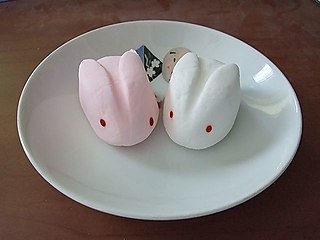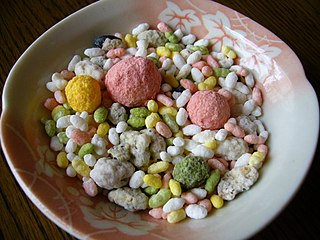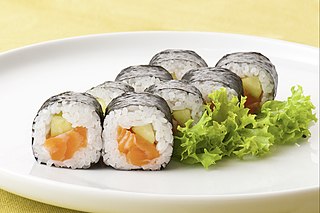
Mochi, is a Japanese rice cake made of mochigome (もち米), a short-grain japonica glutinous rice, and sometimes other ingredients such as water, sugar, and cornstarch. The steamed rice is pounded into paste and molded into the desired shape. In Japan, it is traditionally made in a ceremony called mochitsuki. While eaten year-round, mochi is a traditional food for the Japanese New Year, and is commonly sold and eaten during that time.

A cracker is a flat, dry baked biscuit typically made with flour. Flavorings or seasonings, such as salt, herbs, seeds, or cheese, may be added to the dough or sprinkled on top before baking. Crackers are often branded as a nutritious and convenient way to consume a staple food or cereal grain.

Higashi, is a type of wagashi containing very little moisture, and thus keeps relatively longer than other kinds of wagashi.

Senbei are a type of Japanese rice cracker. They come in various shapes, sizes, and flavors, usually savory but sometimes sweet. Senbei are often eaten with green tea as a casual snack and offered to visiting house guests as a courtesy refreshment.

A rice cake may be any kind of food item made from rice that has been shaped, condensed, or otherwise combined into a single object. A wide variety of rice cakes exist in many different cultures in which rice is eaten and are particularly prevalent in Korea and Japan. Common variations include cakes made with rice flour, those made from ground rice, and those made from whole grains of rice compressed together or combined with some other binding substance.

Kaki no tane or Kaki-pi are a common snack in Japan. The two elements of kaki-pi or kaki-no-tane (柿の種) are small crescent-shaped fragments of senbei, and peanuts. They are often consumed with beer and are sometimes a bar snack. Kaki-pi has several different types of flavors, such as wasabi, pepper, amongst others. The name comes from the fact that the pieces of senbei look like a seed of the persimmon. The "pi" is an abbreviation of piinattsu (ピーナッツ), or "peanuts". In 2017 the food was officially certified "Space Japanese Food" by the JAXA.

Yatsuhashi is a Japanese confection sold mainly as a souvenir snack (miyagegashi). It is one of the best known meibutsu of Kyoto. It is made from glutinous rice flour, sugar, and cinnamon. Baked, it is similar to senbei. The shape of the hard crackers resembles a Japanese harp or koto, or a bamboo stalk cut lengthways.

Bing is a wheat flour-based Chinese food with a flattened or disk-like shape. These foods may resemble the flatbreads, pancakes, pies and unleavened dough foods of non-Chinese cuisines. Many of them are similar to the Indian roti, French crêpes, Salvadoran pupusa, or Mexican tortilla, while others are more similar to cakes and cookies.

Rice flour is a form of flour made from finely milled rice. It is distinct from rice starch, which is usually produced by steeping rice in lye. Rice flour is a common substitute for wheat flour. It is also used as a thickening agent in recipes that are refrigerated or frozen since it inhibits liquid separation.

A rice cracker is an East Asian cracker made from rice flour. They are fried or baked and often puffed and/or brushed with soy sauce or vinegar to create a smooth texture.

Miyagegashi, refers to a sweet made with the purpose of selling it as a souvenir. As with most other Japanese souvenirs, the typical miyagegashi is a regional specialty and cannot be bought outside its specific geographic area. The making and selling of omiyagegashi is an important part of Japan's souvenir industry.

Rengginang or ranginang is a kind of Indonesian thick rice cracker, made from cooked glutinous sticky rice and seasoned with spices, made into a flat and rounded shape, and then sun-dried. The sun-dried rengginang is deep fried with ample cooking oil to produce a crispy rice cracker.

Arare is a type of bite-sized Japanese cracker made from glutinous rice and flavored with soy sauce. The size and shapes are what distinguish arare from senbei. The name is chosen to evoke hailstones – smaller arare are similar in size and shape to hailstones, though others can vary significantly in size, flavor and shape. Arare is also called kakimochi or mochi crunch in Hawaii where it was introduced in the 1900s.

Norimaki (海苔巻) are various Japanese dishes wrapped with nori seaweed, most commonly a kind of sushi, makizushi (巻き寿司).
The Ninja diet was a form of military rations historically consumed by ninjas. The types of rations consumed included suikatsugan, hyōrōgan, kikatsugan, hoshi-ii, and katayaki.














